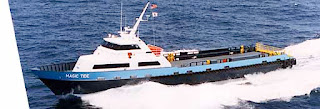 In the September 2008 issue of the United States Naval Institute's magazine Proceedings, the Secretary of the Navy looked at the issue of "An Affordable Naval Presence." It has a sub-head of "We need a more cost-effective Fleet."
In the September 2008 issue of the United States Naval Institute's magazine Proceedings, the Secretary of the Navy looked at the issue of "An Affordable Naval Presence." It has a sub-head of "We need a more cost-effective Fleet."The piece lays out the requirements imposed by our maritime nature:
Our nation's maritime strategy reaffirms the use of sea power to influence actions and activities at sea and ashore, including the need for our naval forces to support humanitarian operations, counter piracy, and assist in capacity building and training of partner nations. The requirement to support these missions moves us to adopt persistent global presence as a key tenet of our strategy. The increasing desire for U.S. Navy presence is one of the driving factors behind our decisions on Fleet size and composition.Ah, there's the rub. Too much ocean, too many shorelines, too many needs, too few ships. What's a navy to do?The value of presence is under-appreciated by many, for they fail to recognize the role of maritime security in support of the world economy to protect it against the vulnerabilities that terrorism and rogue nations pose. Clearly, most would agree that the world is far more connected and interdependent than in years past. Nations have moved away from the idea that they must possess economic self-sufficiency and have largely recognized the value of trade and specialization.
***
The more dispersed nature of today's world trade patterns has major implications for our view of maritime security . . .
Secretary Winter wants analysis of the right ships to build and a more efficient process to build them. All of which is fine, but - there is a faster, cheaper path to get bigger, sooner at lower cost - putting hulls in the water while awaiting that analysis.
Here's my modest proposal:
- Take $250 million dollars and put it aside;
- Of that $250 million, use $100 million to buy or lease 50 to 100 offshore crew boats as currently used in the offshore oil industry (many of them are reaching the end of their expected useful life in the industry - you might be able to pick up some bargains).
- Invest $50 million in refurbishing the boats and in getting weapons for their decks. Turn them into "navalized" vessels. Make 22 knots the minimum acceptable speed.
- Do not try to make these low cost littoral combat ships into battleships for all conditions. Talk to the LCDRs who will be squadron commanders and the LTs who will be the commanding officers about what they would need to provide a presence, fight in a low threat environment against modestly armed pirates and the like, support occasional missions ashore and interdict drug smuggler semi-submersibles. Give them what they need in terms of state of the art comms using COTS (heck, load put a communication van on board if so that no time is wasted trying to rewire the little ships more than needed). Put in some comfortable berthing suited for the sea states in which these things (I call them Special Purpose Vessels or SPVs) will operate.
- Under no cirmcumstance should the total U.S. Navy investment in any single SPV exceed $2 million, excluding the cost of adding weapons systems (adding a M-1 Abrams, for example) and the personnel costs.
- Make the project a 12 month "emergency" - and kill the bureacracy that would ordinarily take on this job - find a hard charging Captain, make him or her report directly to SecNav and tell them what the mission and the budget will be. Then get out of the way except for monthly status reports.
- Find a group of O-3s who are ready for command and who can think for themselves and train the heck out of them by letting them go to sea in the type of ships that you are acquiring, let them learn from the masters of current offshore supply and crew vessels. Find
 some O-4s who can take hold of the idea of being a squadron commander of a 5 ship squardron and train them in mission like that being conducted by the Africa station.
some O-4s who can take hold of the idea of being a squadron commander of a 5 ship squardron and train them in mission like that being conducted by the Africa station. - Borrow some Army Rangers or fleet Marines and train them in the ship boardings, small boat ops, shipboard firefighting and ship defense. Treat them like the Marines of old. Stress people skills appropriate for counterterrorism work.
- Lease some ships to be used as "tenders" for the SPVs - small container ships on which the containers can be shops, supply warehouses, refrigerator units, etc. Bladders for fuel. Use the Arapaho concept to set up a flight deck for helo ops.
- Be generous with UAV assets - use the small "net recoverable" types.
- Don't limit the small boat assets to RHIBs. Experiement with M-ships, small go-fasts captured from drug dealers, whatever. The idea is to have boats that can operate in one sea state worse than the pirates, drug smugglers, etc.
- Use the MIUW van concept for adding some sonar capability. TIS/VIS is a necessity.
Paint Coast Guard like stripe on the hull of the SPVs - but make it Navy blue. If the Coasties want to join in, give them a boat and paint the stripe orange. Make the SPVs highly visible. Nothing deters crime like a visible cop on the beat.
Show the flag.
Please let your thoughts be known.
This post will be on-going...

No comments:
Post a Comment